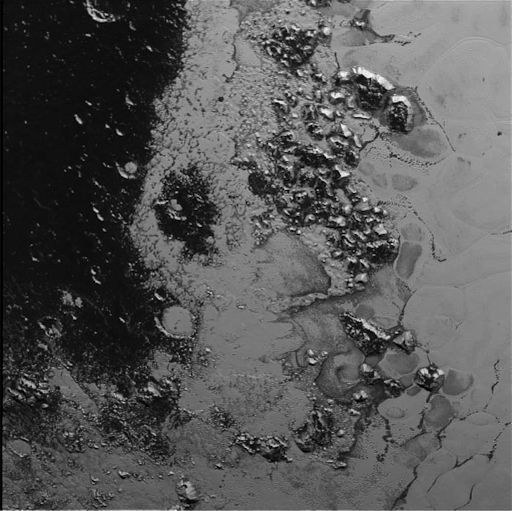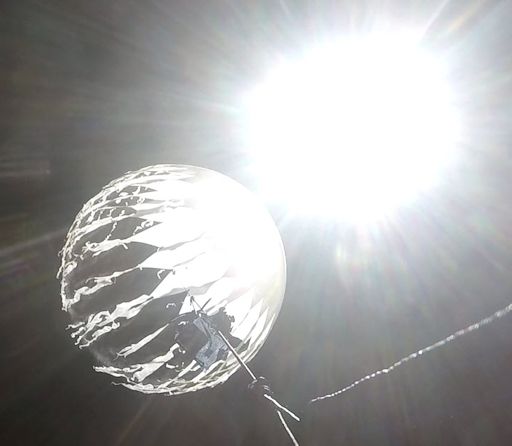Learn to photograph Northern Lights like a pro. Sign up for Peter Rosen's Aurora Photo Courses in Abisko National Park, winner of the TripAdvisor Certificate of Excellence Award 2015. | | |
CHANCE OF STORMS: NOAA forecasters estimate a 45% chance of polar geomagnetic storms on July 23rd when a CME is expected to sideswipe Earth's magnetic field. The CME (movie) was hurled in our direction by a filament of magnetism on the sun, which erupted two days ago. High-latitude sky watchers should be alert for auroras when the CME arrives. [forecast video] Aurora alerts: text or voice.
THE APPALACHIANS OF PLUTO: NASA's New Horizons spacecraft is still beaming back data from last week's stunning flyby of Pluto. The latest discovery to reach Earth is a second range of icy mountains. The newfound peaks are one-half mile to one mile (1-1.5 kilometers) high, about the same height as the United States' Appalachian Mountains:

For comparison, another range of icy mountains reported last week are about twice as tall, akin to Earth's Rockies.
The "Appalachians of Pluto" are located at the lower-left edge of Pluto's best known feature, a bright, heart-shaped region named Tombaugh Regio. They appear to divide a fresh, bright plain on the right from much older and darker terrain to the left.
"There is a pronounced difference in texture between the younger, frozen plains to the east and the dark, heavily-cratered terrain to the west," says Jeff Moore, leader of the New Horizons Geology, Geophysics and Imaging Team (GGI) at NASA's Ames Research Center. "There's a complex interaction going on between the bright and the dark materials that we're still trying to understand."
While the bright plains (Sputnik Planum is believed to be relatively young in geological terms – perhaps less than 100 million years old - the darker region probably dates back billions of years. Moore notes that the bright, sediment-like material appears to be filling in old craters (for example, the bright circular feature to the lower left of center).
Clearly, a lot is happening on Pluto that researchers are only beginning to wrap their minds around. Stay tuned for more surprises.
Realtime Pluto Photo Gallery
TRANSCONTINENTAL SPACE WEATHER BALLOON LAUNCH: For the past two years, the students of Earth to Sky Calculus have been using helium balloons to measure the effect of solar storms on Earth's upper atmosphere. Until this week, their flights were restricted to the airspace over the mountains of central California. Not anymore. On July 20th they conducted the first transcontinental launch of Space Weather Balloons. Scroll past the exploding balloon for more information:

The students released two balloons, simultaneously, 2947 miles apart. One balloon (shown above) exploded 106,326 feet over New Hampshire, while a similar balloon popped above California only minutes later. The two payloads, equipped with an array of X-ray, gamma-ray, and neutron sensors, parachuted back to Earth on opposite sides of the USA. This logistically complicated experiment is a pathfinder: It is teaching us how to build a whole network of launch sites to monitor Earth's atmosphere on continental scales. Data from such a network would lay the groundwork for improved forecasting of cosmic radiation at aviation altitudes, among other things. Stay tuned for updates.
more exploding balloon photos: #1, #2, #3, #4, #5
Realtime Space Weather Photo Gallery
Realtime Aurora Photo Gallery
Realtime Sprite Photo Gallery
Realtime NLC Photo Gallery.
Every night, a network of NASA all-sky cameras scans the skies above the United States for meteoritic fireballs. Automated software maintained by NASA's Meteoroid Environment Office calculates their orbits, velocity, penetration depth in Earth's atmosphere and many other characteristics. Daily results are presented here on Spaceweather.com.
On Jul. 22, 2015, the network reported 14 fireballs.
(12 sporadics, 2 alpha Capricornids)

In this diagram of the inner solar system, all of the fireball orbits intersect at a single point--Earth. The orbits are color-coded by velocity, from slow (red) to fast (blue). [Larger image] [movies]
Potentially Hazardous Asteroids (
PHAs) are space rocks larger than approximately 100m that can come closer to Earth than 0.05 AU. None of the known PHAs is on a collision course with our planet, although astronomers are finding
new ones all the time.
On July 22, 2015 there were potentially hazardous asteroids.
Notes: LD means "Lunar Distance." 1 LD = 384,401 km, the distance between Earth and the Moon. 1 LD also equals 0.00256 AU. MAG is the visual magnitude of the asteroid on the date of closest approach. | | The official U.S. government space weather bureau |
| | The first place to look for information about sundogs, pillars, rainbows and related phenomena. |
| | Researchers call it a "Hubble for the sun." SDO is the most advanced solar observatory ever. |
| | 3D views of the sun from NASA's Solar and Terrestrial Relations Observatory |
| | Realtime and archival images of the Sun from SOHO. |
| | from the NOAA Space Environment Center |
| | the underlying science of space weather |
| | Web-based high school science course with free enrollment |

